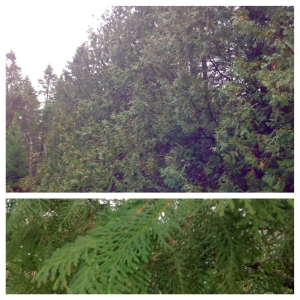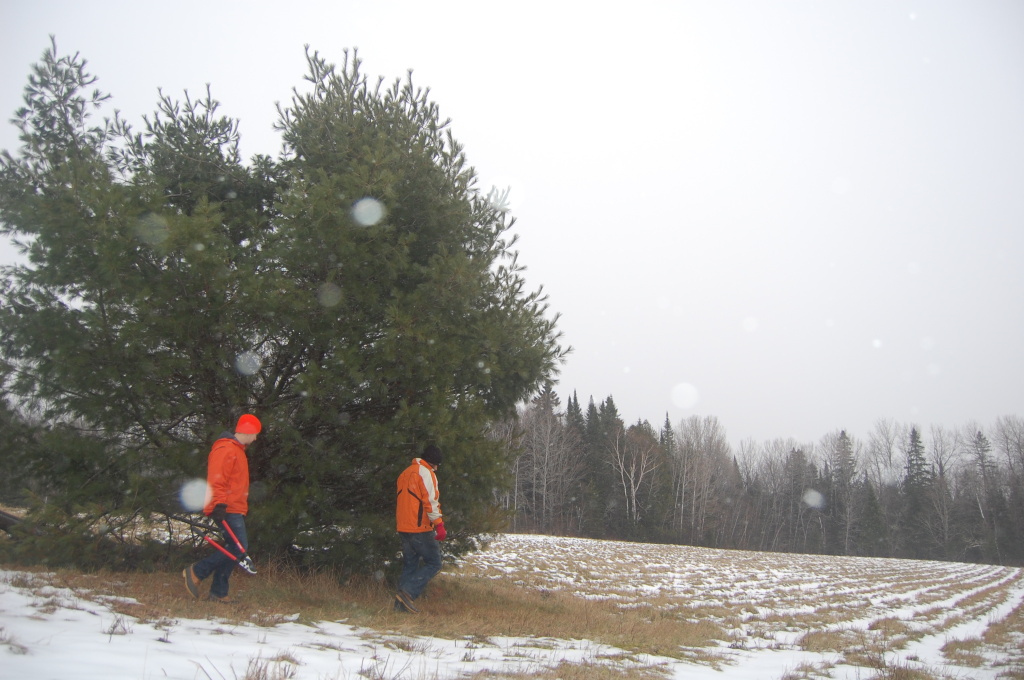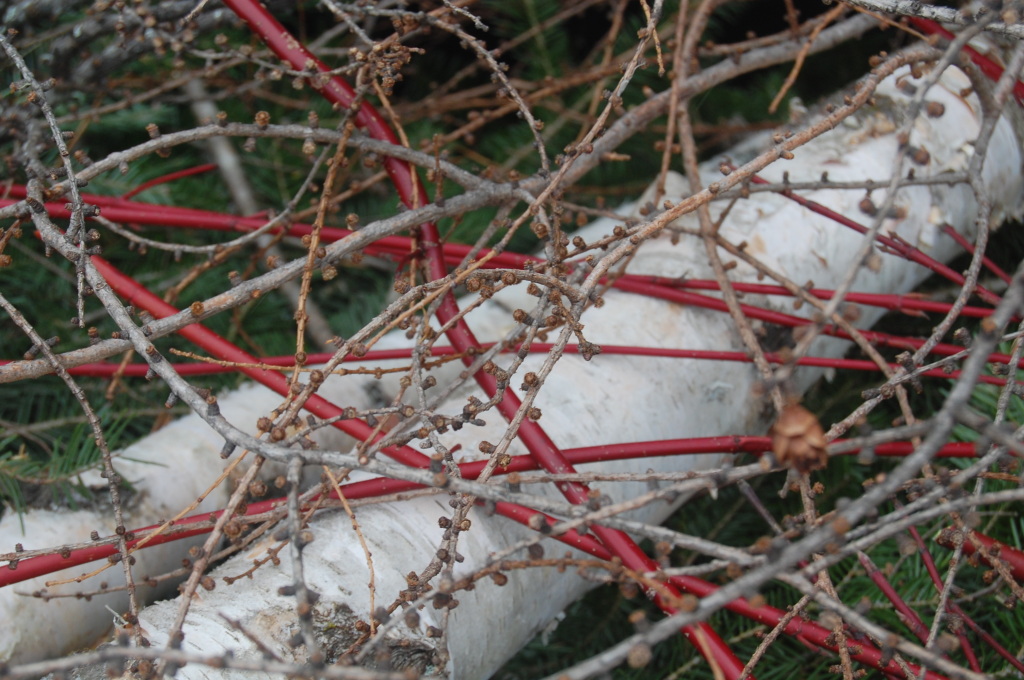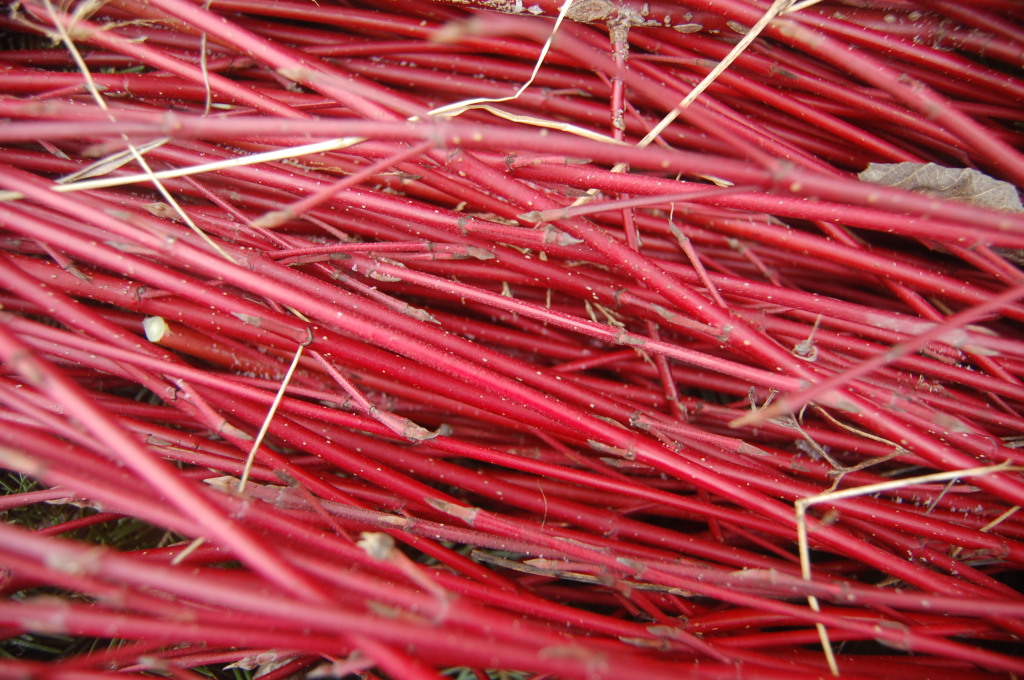Did I get a little carried away with the alliteration there?
The temperatures are dropping, the deciduous leaves have fallen, and our evergreen needles are now set. Thus commences another season of trekking into the woods to gather balsam fir, pine, cedar, moss, red osier dogwood, birch, and tamarack. Be sure to visit our “Handcrafted Holiday Wreaths” page to place your order.
After the great feedback we received after posting “Learn Your Lettuces“, we thought it might be fun to give a rundown of some of the evergreens and twigs we use to make your holiday wreaths, swags, and centerpieces.
Eastern White Pine & Red Pine
Why not start with the pines. Maine is after all the “Pinetree State”. In fact, our state flower is the pinecone and tassel. The pine cone and tassel that you usually see depicted is that of the White Pine. White pine have 5 needles in a cluster, are slender and flexible, and have a bluish green color to them. Their cones are 4-8 inches and tend to be much longer than the Red Pine’s cones. The Red Pine has much broader cones and are shorter. These are the cones we most often use in our holiday wreaths. The Red Pine has 2 needles per cluster, and the needles are dark green.
On our farm we have an old growth forest, and fewer White Pines than other conifers. The White Pines we do have are usually very tall and the trunk does not often have live branches for a lot of its length. Since these White Pines grew up surrounded by many other trees they can sometimes have an irregular shape. Pines can grow to be 100 feet tall and have a diameter of 3 feet. The tallest White Pine on record in Maine was 125 ft tall while the tallest Red Pine is 96 ft.
Collecting pine bows in our field.
Balsalm Fir
Balsalm Fir is the evergreen of choice for the core of our holiday wreaths. There are not many scents in the world more appealing than the fresh scent of balsam. Thankfully, Balsalm Fir is the most abundant tree in Maine. It is often found on well drained hillsides. Evidence of this can be found in one of our favorite fir stands on our farm. Fir trees can appear a bit gothic with sharp, tall spire-like tops. The tree can reach heights of 60–70 feet. A forester who was surveying our forest recently told us we have the largest fir tree he has ever seen in Northern Maine. Now, that is an accomplishment. The aromatic leaves have a central branch from which the needles extend flat on either side. The branches tend to have a whitish underside.
Tamarack
Tamarack, or as we like to call it hackmatack, is a beautiful tree found on our farm in relative abundance. It tends to grow in wetter areas. The Tamarack can grow to a height of 50–60 feet. What makes the Tamarack so unique is that it is the only needle bearing tree in Maine that sheds all its needles in the winter. It first turns a beautiful deep orange/yellow color. We love to use the smaller branches of the tamarack in twig wreaths as they often have adorable, tiny cones attached to them.
Tamarack on red osier dogwood on white birch
Northern White Cedar
Northern White Cedar is another favorite addition to our holiday wreaths, swags, and centerpieces. You tend to observe cedar in soils with higher phs or basic soils. They love the damp conditions and their structure proves it. Cedar is super resistant to rot and is often used for walkways where water is abundant. I remember often hiking on the Appalachian Trail and crossing over cedar planks in swamps. They have also been used for many years as a base layer in “corduroy roads” to make crossing easier in wet areas. Cedar trees can grow to be 60 ft in height. The bark has shallow furrows, and you can peel thin strips quite easily. The needles appear in a net-like fan shape and are very thin and slender. Oh, and the deer love them!

Cedar, from near and afar
Yellow Birch & White Birch
White Birch has become incredibly popular in retail displays over the past few years, and with good reason. The paper like bark is beautiful. Incidentally, if ever you find yourself in need of a fire starter, find yourself some white birch bark and you are in business. Yellow birch is the largest of Maine’s birches and grow up to 85 feet. The bark is as it sounds a yellowish color, especially on younger trees. Both the bark of White Birch and the Yellow Birch have a quality reminiscent of unfurling a roll of ribbon, with many layers laying under the next. It should go without saying you should never do this to a living tree as it might kill it. We love the buds on winter birch twigs and we harvest them readily to make our birch twig wreaths.
Red Osier Dogwood
Red Osier Dogwood might be the most striking of the things we harvest each fall. It is incredibly deep red in color and stands out in a field after all the leaves have fallen. It is quick to spread in areas that have been cleared and is very hardy. The dogwood remains red all winter and is quite beautiful against the backdrop of newly fallen snow. The moose absolutely love the the tips and as we harvest the dogwood each year it is clear which ones the moose have chomped on.
A lot of red osier dogwood




